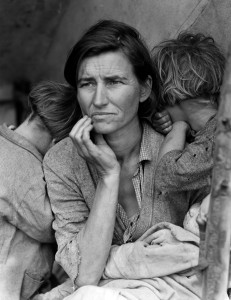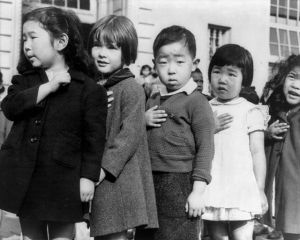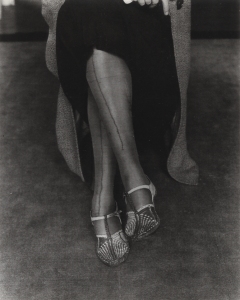Although I may not know much about specific photographers, I can always remember my favorite photos. I was probably around 10 the first time I ever learned about the Great Depression and how devastated our country was during the 1930s. One of my favorite teachers used a photo to teach an entire lesson about that period of American History. She projected an image entitled “The Migrant Mother” on the board. It was a portrait of Florence Christie and her two children taken by Dorothea Lange in 1936 (see below).
I vividly remember my teacher asking each of us to write down what we thought Christie was thinking and/or feeling. To my surprise, it was relatively easy to guess the woman’s emotions and thoughts based on the level of realism displayed in the portrait. Fear, uncertainty and anxiety about the future all came to mind immediately. Looking at the photo, I could almost feel the pain that Christie felt knowing that they only way to keep her children was to pick peas for pennies in California, which was rumored to be a place overflowing with riches at the time. Lange was able to capture the such a wide range of emotions in a still frame, which is beyond impressive.
Lange was not born as an iconic portrait photographer. Like almost everyone else, she has to work her way to the top and overcome much adversity. She was born in 1895 in Hoboken, New Jersey. When she was seven years old, she contracted polio, which left her right leg partially paralyzed. Three years later, Lange’s parents divorced, but were still united in supporting her education.
After high school, Lange studied art form at Columbia University and served as an apprentice to many famous portrait photographers at the time. She married a muralist and 1918, and became more interested in documentary/portrait photography in the 1920s.
In the early 1930s, Lange left her first husband for a whirlwind romance that took her across the country in pursuit of documenting the devastation of the Great Depression and subsequent events in American history. While her new spouse wrote about what they saw, Lange took photos.
While “The Migrant Mother” is definitely the most iconic of Lange’s portraits, I have some other favorites. Below is a portrait of Japanese-American school children pledging allegiance to the flag, immediately prior to the internment of Japanese Americans in 1942. There is nothing more powerful than the innocent ignorance of children.
Another one of my favorite is a photo from 1934 entitled “Mended Stockings.” It brilliantly and bluntly shows the harsh realities the Great Depression; people could not even afford to buy new stockings. Lange shows all of this without a single word.
My favorite thing about Dorothea Lange’s photos are that they give a beautiful face to a time period in American History that was certainly not beautiful. Because her portraits are so shockingly real and simple, there can be no longer be denial or ignorance about their context after viewing them. I’m sure if Lange was still alive today, she would be traveling the country (and probably the world) showing everyone the faces of hardship.
To check out more information about Dorothea Lange, a selection of her works, exclusive articles, and up-to-date Lange exhibition listings, please visit artsy.net.
Resource: “Dorothea Lange.” Bio. A&E Television Networks, 2015. Web. 03 Feb. 2015.


